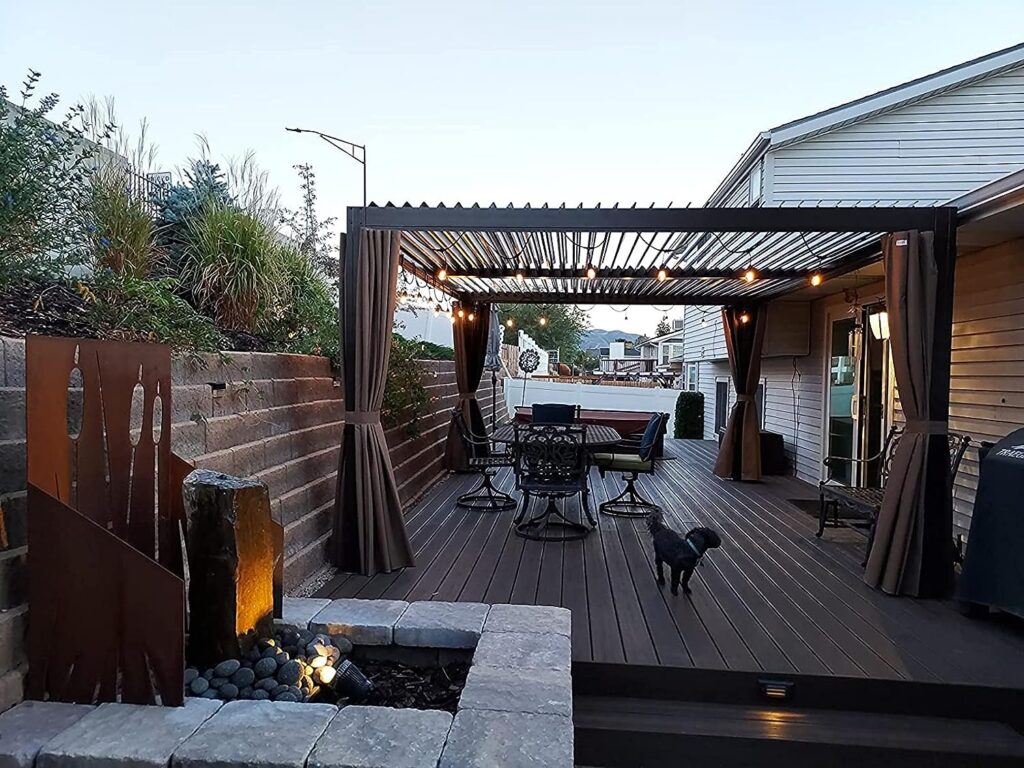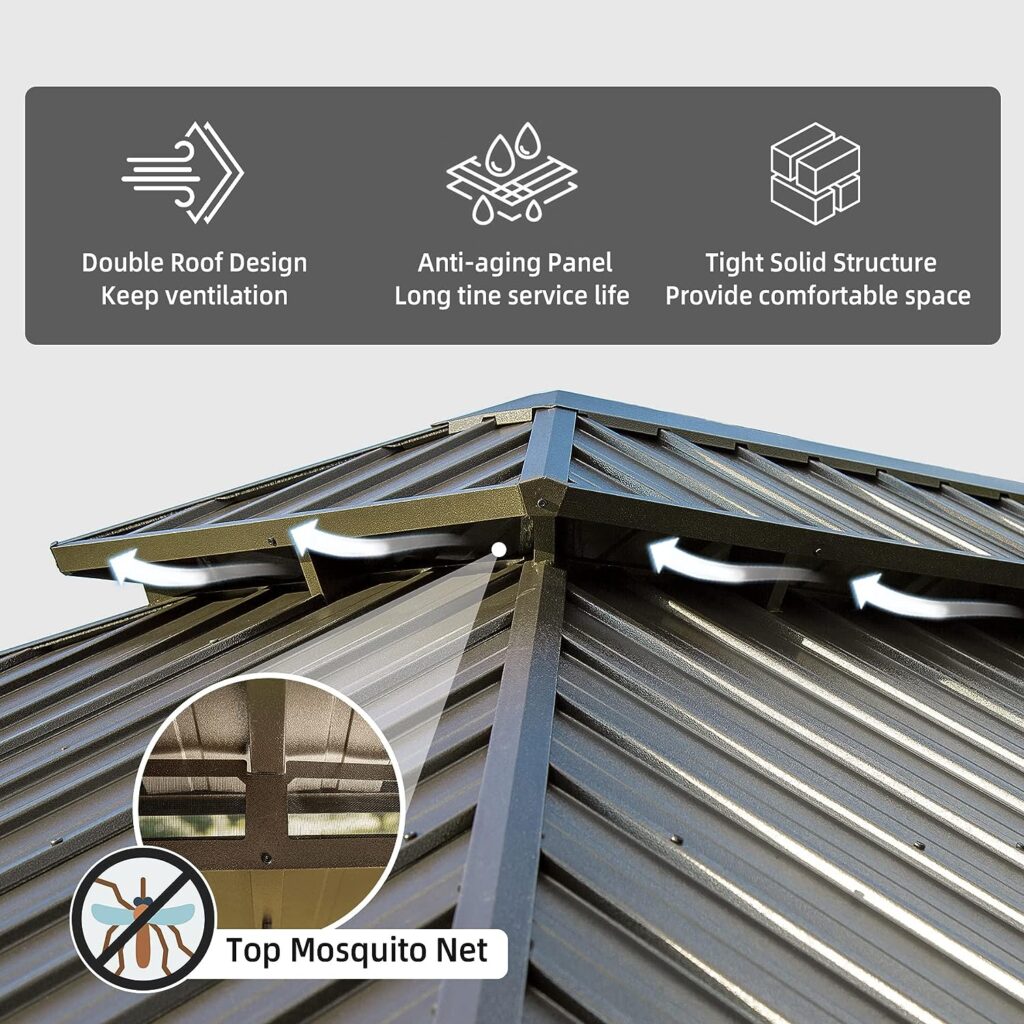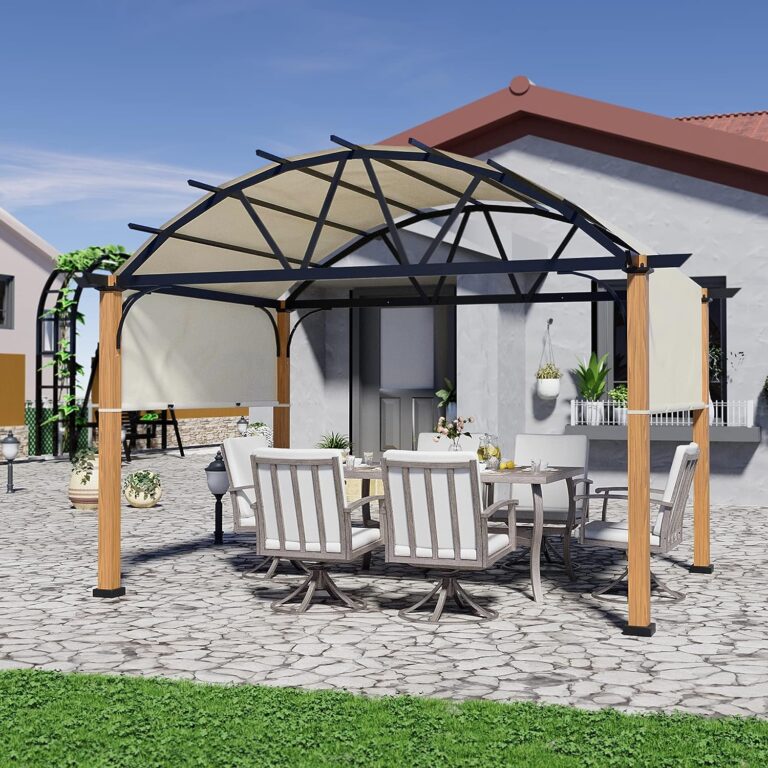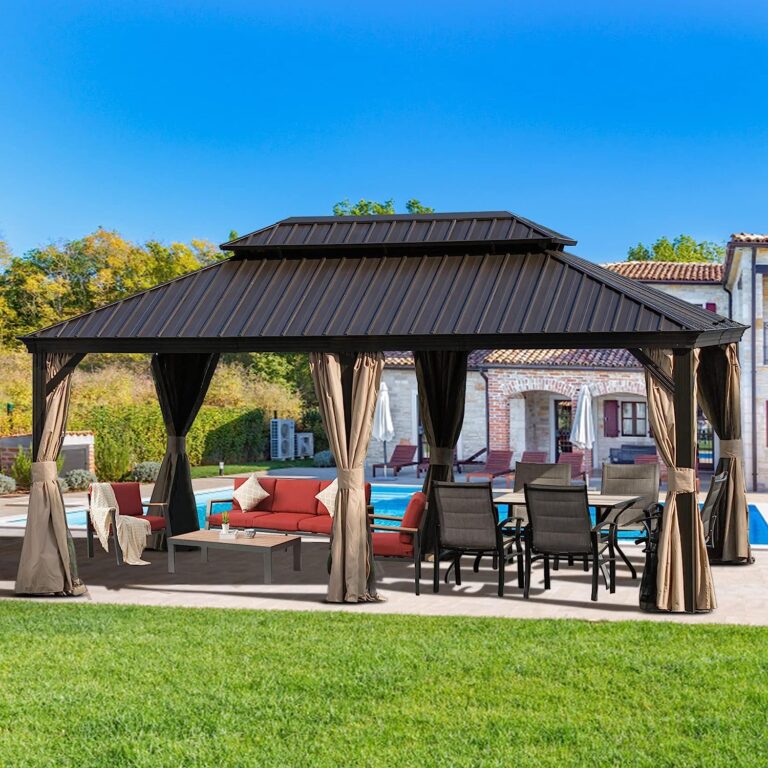The Ultimate Guide to Pergola Roofs: Mastering Your Outdoor Comfort
Looking to add a touch of elegance and functionality to your outdoor space? Look no further than pergola roofs! These versatile structures provide shade and protection from the elements and enhance the aesthetic appeal of any backyard or garden. From classic wooden slats to modern retractable canopies, there are various types of pergola roofs to choose from. Whether you prefer a traditional look or a more contemporary design, this article will guide you through the options available, helping you create the perfect outdoor oasis that suits your style and needs.
Hardtop Pergola Roofs
Materials used in hardtop roofs
Hardtop pergola roofs use durable materials such as aluminum, steel, or polycarbonate panels. These materials are known for their strength and ability to withstand various weather conditions. Aluminum is a popular choice for its lightweight nature and resistance to corrosion. On the other hand, steel offers superior strength but may require regular maintenance to prevent rust. Polycarbonate panels combine strength and light transmission, making them a suitable option for those who desire natural light while enjoying their outdoor space.
Advantages and disadvantages of hardtop roofs
A major advantage of hardtop pergola roofs is their exceptional durability. These roofs are designed to withstand harsh weather conditions, including heavy rain, strong winds, and snow. Unlike softer materials, hardtop roofs do not tear or get damaged easily, ensuring long-lasting protection for your pergola. Hardtop roofs provide excellent shade and protection from harmful UV rays, allowing you to enjoy your outdoor space comfortably.
However, hardtop roofs can come with a higher price tag than other options. The materials used, especially aluminum and steel, can be more expensive. Furthermore, installing a hardtop roof may require professional assistance, adding to the overall cost. Additionally, hardtop roofs are not easily adjustable, meaning you cannot easily control the amount of sunlight and shade that filters through.
Cost considerations for hardtop roofs
When considering a hardtop pergola roof, it’s important to factor in the cost of materials, installation, and additional features. The price of a hardtop roof can vary significantly depending on the size of your pergola, the materials chosen, and whether you opt for a DIY installation or hire professionals. Obtaining quotes from different suppliers and contractors is advisable to ensure you are getting the best value for your money. While hardtop roofs may have a higher upfront cost, their durability can make them a cost-effective choice in the long run, as they require minimal maintenance and can last for many years.
Soft-top Pergola Roofs

Materials used in soft-top roofs
Soft-top pergola roofs are typically made from fabrics such as canvas or polyester. These lightweight materials offer flexibility, allowing for easy installation and adjustment. Canvas is popular for its natural aesthetics and ability to block out a significant amount of sunlight. Polyester, on the other hand, is known for its durability and resistance to fading and mold.
Suitability of soft-top roofs
Soft-top roofs are best suited for pergolas in areas with milder weather conditions. They balance shade and natural light, creating a cozy and inviting outdoor space. Soft-top roofs are relatively easy to install and can be adjusted to control the sunlight that filters through. They are also affordable compared to hardtop roofs, making them an attractive choice for those on a budget.
Maintaining a soft-top roof
Regular maintenance is essential to ensure the longevity of a soft-top pergola roof. Keeping the roof clean and free from dirt, debris, and moss is important, as these can cause damage and decrease the fabric’s lifespan. Most soft-top roofs can be easily cleaned using mild soap and water or a fabric cleaner designed for outdoor use. Additionally, removing the soft-top roof during winter or extreme weather conditions is advisable to prevent unnecessary wear and tear. Storing the roof in a dry and protected area will help prolong its lifespan.
Louvered Pergola Roofs

How does a louvered roof work?
Louvered pergola roofs consist of slats or panels that can be adjusted to control the amount of sunlight and ventilation in your outdoor space. These slats can be manually operated or motorized, providing convenience and flexibility. By angling the slats, you can create shade, increase airflow, or allow sunlight to filter through, depending on your preference.
Pros and cons of louvered pergola roofs
One of the main advantages of louvered roofs is their versatility. You have full control over the amount of sunlight and shade in your outdoor space, allowing you to create a comfortable environment throughout the day. The adjustable slats also provide excellent ventilation, reducing the buildup of heat and humidity. Additionally, louvered roofs add an aesthetic appeal to your pergola, giving it a modern and sophisticated look.
However, louvered roofs can be more expensive than other options due to their advanced mechanism. The motorized version of a louvered roof requires professional installation, which can increase the overall cost. Additionally, the maintenance and repair of the motorized components may require specialized assistance. It’s important to consider these factors when determining the feasibility of a louvered roof for your pergola.
Considering weather conditions for louvered roofs
Louvered roofs are particularly suitable for areas with varying weather conditions. By adjusting the slats, you can protect your outdoor space from rain, snow, or direct sunlight. Closing the slats completely creates a waterproof roof, ensuring you can enjoy your pergola even during a heavy downpour. However, it is important to note that louvered roofs may not provide the same level of insulation as solid roofs, and extreme weather conditions may require additional protection or the closing of the slats to prevent damage.
Metal Pergola Roofs

Types of metal roofing for pergolas
When opting for a metal pergola roof, there are several types of metal to consider, each with its own benefits and characteristics. Aluminum is a popular choice due to its lightweight nature, resistance to corrosion, and durability. It is also available in various colors and finishes, allowing customization to match your aesthetic preferences. Steel is another option known for its strength and longevity. While steel requires more maintenance to prevent rust, it provides excellent structural support and is often chosen for larger pergolas. Other options include copper, which develops a beautiful patina over time, and zinc, which offers exceptional corrosion resistance.
Durability and maintenance of metal roofs
Metal roofs for pergolas are known for their durability and ability to withstand various weather conditions. They are resistant to cracking, warping, and rotting, making them a long-lasting choice for outdoor space. Additionally, metal roofs require minimal maintenance, usually limited to cleaning debris and dirt. Regular inspections for any signs of damage or corrosion are also advisable to ensure the roof’s structural integrity. Depending on the type of metal chosen, applying a protective coating or paint can further enhance the longevity and aesthetics of the roof.
Design possibilities with metal roofs
Metal roofs offer a wide range of design possibilities for your pergola. They can be shaped and formed into different profiles, allowing for unique and creative designs. Whether you prefer a modern, industrial look or a more traditional style, metal roofs can be customized to reflect your personal taste. Additionally, the availability of various colors and finishes allows you to match your pergola roof with the overall theme of your outdoor space. The versatility and design options of metal roofs make them popular for those seeking a visually striking and durable roofing solution.
Polycarbonate Pergola Roofs
Features of polycarbonate roofs
Polycarbonate roofs are constructed using translucent panels made from a thermoplastic material. These panels offer durability, light transmission, and impact resistance. Polycarbonate roofs allow natural light to illuminate your outdoor space while protecting it from harmful UV rays. The panels are available in various colors, thicknesses, and finishes, allowing you to choose the one that best suits your needs.
Advantages and drawbacks of polycarbonate roofing
One of the main advantages of polycarbonate roofing is its UV protection. The panels are designed to block harmful UV rays, providing a safe and comfortable environment. Polycarbonate roofs are also lightweight, making them easy to install and transport. They are also highly impact-resistant, reducing the risk of falling debris or hail damage. However, it is important to note that while polycarbonate panels are durable, they may not be as strong as other materials, such as metal or hardtop roofs. Extreme weather conditions like heavy snow or strong winds may require additional support or protection.
UV protection and longevity of polycarbonate roofs
Polycarbonate roofs are designed to provide UV protection, making them an excellent choice for those concerned about sun exposure. The panels are coated with a protective layer that blocks harmful UV rays while allowing natural light to filter through. This UV protection prevents fading and damage to your pergola furniture and flooring. Additionally, polycarbonate roofs have a long lifespan when properly maintained. Regular cleaning and inspection for any signs of damage or wear can help ensure the longevity of your polycarbonate roof.
Retractable Pergola Roofs
Mechanism of a retractable roof
As the name suggests, retractable pergola roofs can be extended or retracted to provide shade or allow sunlight into your outdoor space. These roofs are typically supported by a frame with a retractable fabric or louvers that can be adjusted to control the desired coverage. Some retractable roofs are manual and require manual adjustment, while others are motorized for enhanced convenience.
Weather protection and flexibility of retractable roofs
Retractable roofs provide excellent weather protection by allowing you to adjust the coverage based on the current weather conditions. During hot summer days, you can extend the roof fully to create shade and protect yourself from the sun’s rays. In contrast, you can retract the roof partially or fully on cooler days or when you desire more natural light. This flexibility allows you to optimize your outdoor space throughout the year, regardless of the weather. Additionally, some retractable roofs are designed to be waterproof, providing protection from rain and ensuring that you can continue to enjoy your outdoor space even during light showers.
Cost factors of retractable pergola roofs
The cost of a retractable pergola roof can vary depending on several factors, including the roof size, the type of mechanism (manual or motorized), the materials used, and the complexity of the installation. Motorized retractable roofs generally have a higher upfront cost due to the additional electrical components and professional installation required. However, manual retractable roofs may require more effort to operate and adjust. It is important to consider your budget and the level of convenience you desire when selecting a retractable pergola roof for your outdoor space.
Thatched Pergola Roofs
Aesthetic qualities of thatch
Thatched pergola roofs offer a unique and natural aesthetic that adds warmth and character to your outdoor space. Thatch is typically made from dried plant materials such as straw, reed, or palm leaves. These materials create a rustic and inviting atmosphere reminiscent of tropical retreats. Thatched roofs blend seamlessly with natural surroundings, creating a harmonious environment that is pleasing to the eye.
Sustainability and the thatching process
Thatching is an environmentally friendly roofing option utilizing renewable and natural resources. The plant materials used in thatch roofs are biodegradable and do not contribute to landfill waste. Thatching also promotes preserving traditional craft skills, requiring specialized knowledge and techniques. Thatchers carefully select and arrange plant materials to create a tight, weatherproof roof. While the lifespan of a thatched roof can vary depending on the materials used and local weather conditions, with proper maintenance, a thatched roof can last for many years.
Keeping a thatched pergola roof weatherproof
Regular maintenance is necessary to maintain the weatherproof qualities of a thatched pergola roof. The roof should be inspected periodically for any signs of damage, such as loose thatch or pest infestations. Thatched roofs may require occasional rethatching or fire retardant treatments to ensure their safety and longevity. Additionally, it is advisable to remove any debris, such as leaves or branches, that may accumulate on the roof, as these can trap moisture and lead to decay. With proper care and maintenance, a thatched pergola roof can provide a charming and durable covering for your outdoor space.
Gabled Pergola Roofs
Structural features of a gabled roof
Gabled pergola roofs are characterized by their triangular shape, with two sloping sides that meet at a ridge in the middle. This design offers several benefits, including increased vertical space and improved ventilation. The roof’s steep slope allows for efficient rainwater drainage, reducing the risk of leaks or water damage. Additionally, the gabled structure provides stability, making it suitable for pergolas in areas with strong wind conditions.
Benefits and limitations of gabled pergola roofs
One of the main benefits of gabled roofs is their aesthetic appeal. The symmetrical design and triangular shape add a sense of grandeur and elegance to your outdoor space. The higher peak of the roof also creates a spacious and open atmosphere, allowing for better air circulation. However, it is important to note that gabled roofs may be more expensive to construct than other roof styles due to the increased materials and construction complexity. When considering a gabled pergola roof, assessing the structural requirements and cost implications is important to ensure it is suitable for your specific needs.
Customizing a gabled pergola roof
Gabled roofs offer various customization options to fit your personal style and preferences. The choice of roofing materials, such as shingles, tiles, or metal, allows you to create a roof that complements the overall design of your outdoor space. The roof slope angle can also be tailored to your specific needs, depending on factors such as your geographical location and desired aesthetic. Additionally, gabled roofs can be combined with other features, such as skylights or windows, to maximize natural light and ventilation in your pergola. The flexibility and design possibilities of gabled roofs make them popular for those seeking a visually striking and functional roofing option.
Flat Pergola Roofs
Design benefits of a flat roof
Flat pergola roofs offer a sleek, modern design aesthetic that complements contemporary outdoor spaces. A flat roof’s clean lines and simplicity create a minimalist and sophisticated look. Additionally, the flat surface provides a versatile space that can be utilized for various purposes, such as placing solar panels, creating a rooftop garden, or installing a retractable canopy. The overall design flexibility of flat roofs makes them an attractive option for those seeking a customizable and modern outdoor space.
Drainage and maintenance concerns for flat roofs
One of the main considerations for flat roofs is proper drainage. Unlike sloped roofs, flat roofs do not have a natural slope to facilitate water runoff. Therefore, ensuring that the roof is designed with an effective drainage system in place is essential. This may include built-in gutters, drainage pipes, or a slight slope in the roof surface. Regular inspection and maintenance of the drainage system are necessary to prevent water accumulation and potential leaks or water damage. Additionally, flat roofs may require more frequent cleaning and debris removal to avoid clogged drains and potential structural issues.
Material options for flat pergola roofs
Flat pergola roofs can be constructed using various materials, each with its own benefits and considerations. Some popular options include metal, such as aluminum or steel, which provide durability and sleek aesthetics. Other options include polycarbonate panels, which balance natural light transmission and UV protection. Wood is also common for flat roofs, providing a warm and natural look. When selecting the material for your flat pergola roof, it is important to consider weather conditions, maintenance requirements, and overall design preferences.
Open Top Pergola Roofs

Creating shade with open-top designs
Open-top pergola roofs are designed to provide shade and openness, creating a comfortable outdoor space. The absence of a solid roof allows dappled sunlight to filter through, creating a pleasant ambiance. The open design also provides better airflow, reducing the buildup of heat and humidity. Open-top pergolas often incorporate elements such as retractable canopies, pergola covers, or shade sails to create shade. These features allow you to adjust the amount of shade based on your preference and the current weather conditions.
Weather considerations for open-top pergolas
When opting for an open-top pergola roof, it is important to consider the weather conditions in your area. While open designs offer excellent ventilation, they may not provide sufficient protection during extreme weather events or heavy rain. However, by utilizing additional shade elements, such as retractable canopies or shade sails, you can enhance the weather resistance of your pergola. It is also advisable to select materials resistant to fading, moisture, and other outdoor elements when constructing an open-top pergola roof.
Popular materials for open-top pergola roofs
Open-top pergola roofs can be constructed using various materials, depending on your desired aesthetics and functional requirements. Wood is a popular choice for its natural beauty and versatility. It can be shaped, stained, or painted to match your outdoor design. Another option is aluminum, which offers durability and resistance to corrosion. Aluminum roofs can be designed with lattices or open frameworks, providing shade and openness. Additionally, shade fabric or sailcloth can create a retractable cover, allowing you to adjust the amount of shade based on your preference. The material selection for your open-top pergola roof will depend on factors such as maintenance requirements, durability, and the desired level of shade and openness.
In conclusion, various types of pergola roofs are available, each with unique features, advantages, and considerations. Whether you prefer the durability of a hardtop roof, the flexibility of a retractable roof, or the natural aesthetics of a thatched roof, there is a pergola roof option to suit your needs and preferences. When selecting a pergola roof, it is important to consider factors such as weather conditions, maintenance requirements, cost considerations, and design preferences. By choosing the right pergola roof, you can create an outdoor space that is both functional and visually appealing, allowing you to enjoy the beauty of nature while being protected and comfortable.





